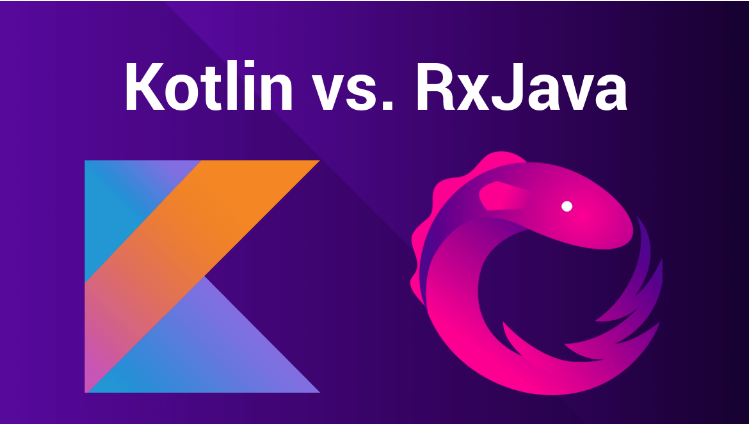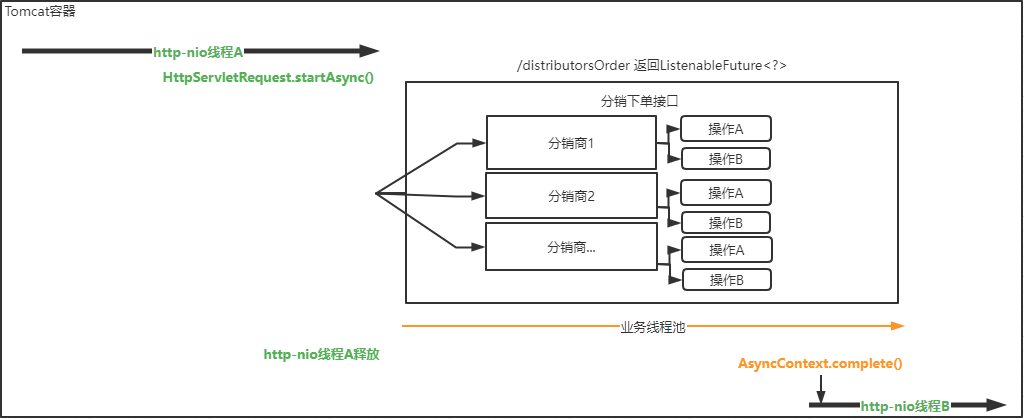
本文探讨的是在tomcat服务端接口编程中, 异步servlet场景下( 参考我另外一个文章),用rxjava来改造接口为全流程异步方式
好处不用说
-
tomcat的worker线程利用率大幅提高,接口的并发能力提升 -
全流程无阻塞等待式(非例如像Future.get这种伪异步) -
业务逻辑处理上多个操作上无依赖的可以并发处理,接口性能大幅提高
但是缺点也没法逃避
-
编码复杂度增加 -
回调地狱,原来同步几十行代码可能要变成几百行代码 -
难以调试,大部分代码都是以链式表达式的形式出现,出错了问题定位难
解决这些缺点,在其他语言上有
-
csharp/js 的 async await -
go的 goroutine channel
实现上有的是语法层面,有的是语法糖(编译成状态机),抛开机制不同,他们都是为了解决了一个关键问题:
-
它帮你去做复杂的线程切换 -
让你像写同步代码一样去写异步代码
那么java咋办,作为同时jvm语言的kotlin的Coroutine(协程)可以帮到我们!
回到刚开头说的探讨场景,可能有人会觉得奇怪,如果用kotlin的话,有kotlin方式的服务端异步编程框架啊,比如ktor。或者spring webflux + kotlin suspend等 没错,建议都采用这种方式最好! 那在源头上就是非上面的,我们又如何利用kotlin的协程,是今天主要讨论的话题!
设定一个业务场景
这里举例下分销订单接口, 不同的分销商都得call一次,call完后还要根据结果来做别的操作(A和B)。 假设有5个分销商 因为每个分销商之间没有依赖,所以优化方式自然想到用rxjava来改造!
要想在tomcat容器里实现全流程异步, 那肯定是用异步servlet的方式,如上图所示,tomcat的nio线程调用业务接口返回ListenableFuture, 会调用addListener设定一个callback,在callback里面进行异步上下文的提交
//异步servlet标准式操作
final AsyncContext asyncContext = request.startAsync();
final ListenableFuture<?> responseFuture = distributorsOrder();//业务方法
responseFuture.addListener(() -> {
try {
// 略
} catch (Throwable ex) {
_logger.error("Execute async context error!", t);
} finally {
asyncContext.complete();
}
}, executorService);用rxjava的实现方式(示意伪代码)
private Single<Optional<List<String>>> createByAsync(Detail orderItem) {
List<Single<Optional<List<String>>>> singleOptList = new ArrayList<>();
for (List<Distributor> distributor : distributorList) {
Single<Optional<List<String>>> orderId = distributor
.createOrderAsync(orderItem);
singleOptList.add(orderId);
}
return Single.zip(singleOptList, objects -> {
//回调处理略
return Optional.of(result);
});
}
Single<Optional<List<String>>> createDistributorOrderSingle = createByAsync(orderItem);
createDistributorOrderSingle.flatMap( (Function<Optional<List<String>>, SingleSource<List<ResultEntity>>>) objects -> {
Single<Optional<List<ActionAResult>>> actionASingle = getActionABySoaAsync(objects);
Single<Optional<List<ActionBResult>>> actionASingle = getActionBBySoaAsync(objects);
return Single.zip(actionASingle, actionASingle, (actionATypes, actionBTypes) -> {
// 回调处理略
return resultEntity;
});
});可能你第一次写完,尽管看起来很复杂,但是一看95线明显降低,是不是觉得还有点成就感呢, 后面业务变得复杂,继续叠加callback, 排查报错,一堆函数式链路,是不是觉得很难受。 好吧,这个项目重构代价太大了,那么后面你在写一个新业务的时候,你会还想要这么写吗? 有没有别的刚好的方式呢?
kotlin协程一般我们都微服务化,基本上调用都是通过微服务框架方式调用,微服务框架层一般会提供代理类来封装。 那么我们就可以通过包装代理类来实现kotlin的协程调用方式(灵感来自retrofit)
在设计这个功能的时候,我首先会想,暴露出来的使用方式怎么样是友好的,包括写单元测试。 那就是面向接口封装
interface SoaClientInterface {
suspend fun soaMethod1(request: GetMethod1RequestType): GetMethod1ResponseType
}
@RunWith(SpringRunner::class)
@SpringBootTest(webEnvironment = SpringBootTest.WebEnvironment.NONE)
class SoaClientTest {
@SoaClass
private lateinit var soaClients: SoaClientInterface
@Test
fun test() = runBlocking {
val resaponse = soaClients.soaMethod1(request)
}
}如上,我要调用的微服务方法 soaMethod1 (suspend方法) 我把他定义到一个interface里面,然后我在使用的时候只需要打上一个注解@SoaClass 在使用的时候就直接用就可以了。
这样一来, soaMethod1 原本是返回ListenableFuture 被我包装成一个代理类,代理类返回的是Coroutine 借助suspend语法糖,内部会帮我们自动切换上下文。
实现思路 @SoaClass注解是我自定义的spring BeanPostProcessor 处理标识, 在spring容器的流程中,会发掘打了这个注解的field并注入我自定义的接口实现类!
SoaClientFactory我的接口实现类的目的是为了包装ListenableFuture为suspend的Coroutine方式调用
这里用jdk的proxy功能创建代理类,当调用代理类的任何方法,都会走到这里
public <T> T create(final Class<T> service, ISoaFactory soaFactory) throws Exception {
validateServiceInterface(service, soaFactory);
return (T) Proxy.newProxyInstance(service.getClassLoader(), new Class<?>[]{service}, new InvocationHandler() {
private final Object[] emptyArgs = new Object[0];
@Override
public @Nullable Object invoke(Object proxy, Method method, @Nullable Object[] args) throws Throwable {
// If the method is a method from Object then defer to normal invocation.
if (method.getDeclaringClass() == Object.class) {
return method.invoke(this, args);
}
args = args != null ? args : emptyArgs;
return method.isDefault() ?
invokeDefaultMethod(method, service, proxy, args) :
loadServiceMethod(method, soaFactory).invoke(args);
}
});
}代理接口定义的每个方法都会解析成一个SoaServiceMethod<?>,缓存起来下次调用
SoaServiceMethod<?> loadServiceMethod(Method method, ISoaFactory soaFactory) throws Exception {
SoaServiceMethod<?> result = serviceMethodCache.get(method);
if (result != null) {
return result;
}
synchronized (serviceMethodCache) {
result = serviceMethodCache.get(method);
if (result == null) {
result = SoaServiceMethod.parseAnnotations(method, soaFactory);
serviceMethodCache.put(method, result);
}
}
return result;
}每个方法需要去解析且拿到以下信息
-
原本的调用的方法名称 -
请求类型 -
返回类型 -
是否是kotlin的suspend方式
SoaRequestFactory build() {
int parameterCount = parameterAnnotationsArray.length;
if (parameterCount > 2 || parameterCount < 1) {
throw new IllegalArgumentException("Method request parameterCount invalid"
+ "\n for method "
+ method.getDeclaringClass().getSimpleName()
+ "."
+ method.getName());
}
try {
if (TypeUtils.getRawType(parameterTypes[parameterTypes.length - 1]) == Continuation.class) {
isKotlinSuspendFunction = true;
}
} catch (NoClassDefFoundError ignored) {
// Ignored
}
if (!isKotlinSuspendFunction && parameterCount > 1) {
throw new IllegalArgumentException("Method request parameterCount invalid"
+ "\n for method "
+ method.getDeclaringClass().getSimpleName()
+ "."
+ method.getName());
}
Type returnType = method.getGenericReturnType();
if (hasUnresolvableType(returnType)) {
throw new IllegalArgumentException(String.format("Method return type must not include a type variable or wildcard: %s", returnType)
+ "\n for method "
+ method.getDeclaringClass().getSimpleName()
+ "."
+ method.getName());
}
if (returnType == void.class) {
throw new IllegalArgumentException("Service methods cannot return void."
+ "\n for method "
+ method.getDeclaringClass().getSimpleName()
+ "."
+ method.getName());
}
// 返回类型
Type adapterType;
if (isKotlinSuspendFunction) {
adapterType =
TypeUtils.getParameterLowerBound(
0, (ParameterizedType) parameterTypes[parameterTypes.length - 1]);
if (TypeUtils.getRawType(adapterType) == AsyncResult.class && adapterType instanceof ParameterizedType) {
adapterType = TypeUtils.getParameterUpperBound(0, (ParameterizedType) adapterType);
continuationWantsResponse = true;
}
continuationIsUnit = isUnit(adapterType);
} else {
adapterType = returnType;
}
this.requestType = method.getParameterTypes()[0];
this.responseType = (Class<?>) adapterType;
this.methodName = method.getName();
return new SoaRequestFactory(this);
}如果是kotlin的suspend方式 那么需要在java里面直接调用kotlin写的扩展方法
@Override
Object invoke(Object[] args) {
Continuation<ResponseT> continuation = (Continuation<ResponseT>) args[args.length - 1];
try {
return SoaExtendKotlinKt.await(soaClient, args[0], continuation);
} catch (Exception e) {
return SoaExtendKotlinKt.suspendAndThrow(e, continuation);
}
}这里是最核心的实现方式 ListenableFuture -> suspend func
suspend fun <T : Any, K : Any> SoaClient<T, K>.await(request: T): K? {
return suspendCancellableCoroutine { continuation ->
continuation.invokeOnCancellation {
this.cancel()
}
Futures.addCallback(
this.handleAsync(request),
CatAsync.wrap(object : FutureCallback<K> {
override fun onSuccess(result: K?) {
continuation.resume(result)
}
override fun onFailure(t: Throwable) {
continuation.resumeWithException(t)
}
}), ThreadPool.INSTANCE
)
}
}只要思路定下来,技术细节实现就很简单了。 那么这么一包装,用的时候的好处怎么体现出来呢?我们把上面用rxjava的实现的伪代码换成kotlin方式的伪代码
interface SoaClientInterface {
suspend fun createOrderAsync(request: CreateOrderRequestType): CreateOrderResponseType
}
@SoaClass
private lateinit var soaClients: SoaClientInterface
suspend func createDistributorsOrder(request:createRequestType)=coroutineScope{
val channel = Channel<List<User>>()
for (distributor in distributorList) {
launch {
// 并发调用
val users = soaClients.createOrderAsync(CreateOrderRequestType().also{
it.orderItem = request.orderItem
it.distributorId = distributor.id
})
.also { log(repo, it) }
.bodyList()
channel.send(users)
}
}
repeat(distributorList.size) {
val rt = channel.receive()
//处理其他 suspend
}
}采用了协程Coroutine的方式解决了异步回调,如果有报错也非常清楚(归功于kotlin的Coroutine的功能强大) 其中最难的是依赖对方提供的方法返回的是ListenableFuture 如何包装成 suspend func 来达到整体的suspend一路到底的全链路异步方式~!
我是正东,追求高效率编程~

如果您觉得阅读本文对您有帮助,请点一下“推荐”按钮,您的“推荐”将是我最大的写作动力!欢迎各位转载,转载文章之后须在文章页面明显位置给出作者和原文连接,谢谢。
